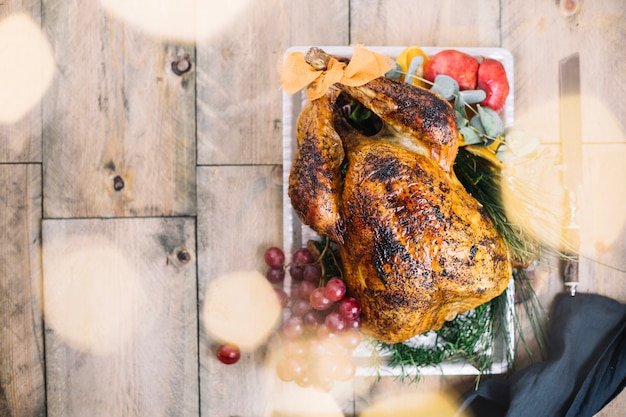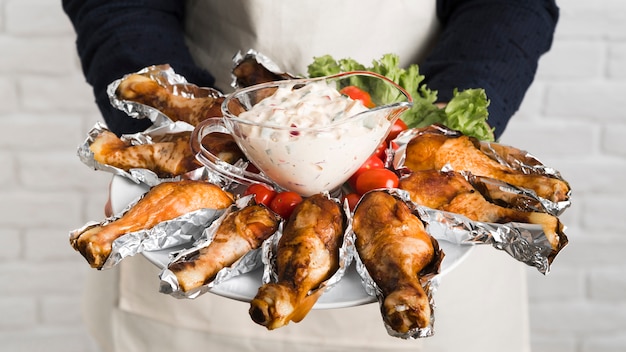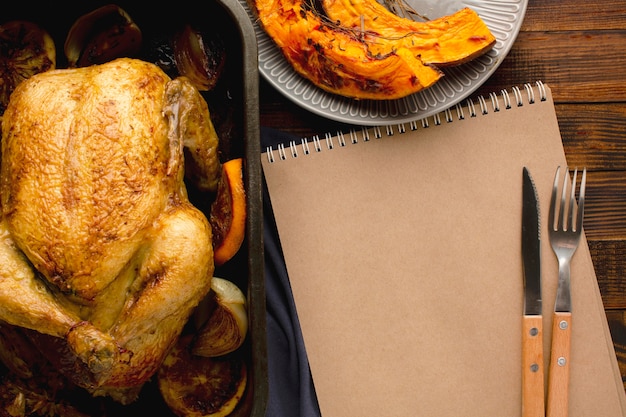Oh, turkey wings! They're a personal favourite of mine. You just can't beat a perfectly roasted turkey wing – succulent, juicy, and bursting with flavour. They're incredibly affordable, making them a fantastic choice for a budget-friendly meal. This guide is your ultimate resource, bringing together years of my personal cooking experiments and a few beloved family recipes. We'll cover everything from choosing the perfect wings to mastering the roasting technique, making your turkey wings sing with deliciousness. Grab your favourite mug, settle in, and let’s embark on this culinary adventure!
(Part 1) Choosing the Right Wings: Finding Your Perfect Match

Picking Your Wings: Drumsticks vs Wings
When it comes to turkey wings, you've got a choice to make: drumsticks or wings. And it's not just about personal preference! Each type has its own unique character, catering to different tastes and needs.
- Drumsticks: These are the beefy, full-bodied stars. They're packed with meaty goodness and have a richer flavour, making them perfect for those who crave a hearty meal.
- Wings: These are the leaner, more slender cousins. They're great for a lighter meal, especially if you prefer a crispy texture. They’re also great for smaller appetites.
What to Look For: The Signs of Freshness
No matter your choice, there are a few telltale signs to look for when selecting turkey wings to ensure they're fresh and ready to be cooked into culinary magic.
- Colour: Fresh turkey wings boast a pale, creamy white skin. If you notice any yellowing, it's a sign the wings might be past their prime.
- Smell: Freshness radiates in the mild, pleasant aroma of fresh turkey wings. Any sour or ammonia-like scent is a definite red flag.
- Texture: A gentle press should reveal firm, springy flesh. If it feels soft or mushy, it's best to pass those wings by.
(Part 2) Preparing the Wings: Setting the Stage for a Delicious Roast

Getting Started: A Simple Rinse and Dry
Once you've secured your perfect wings, it's time to prep them for their star turn in the oven. The first step is a simple yet essential one – giving them a thorough rinse under cold running water. It's all about removing any lingering debris or residue. Then, pat them dry using paper towels or a clean kitchen cloth.
The Salt Rub: A Foundation for Flavor
I'm a firm believer in the power of a dry rub. It's a magic touch that brings a layer of depth to the flavour and creates a wonderful, crispy texture. Here's a classic salt rub that sets the stage for flavour:
- 1 tablespoon of salt: This simple seasoning brings out the natural flavour of the turkey.
- 1/2 teaspoon of black pepper: This adds a touch of warmth and a subtle kick.
Combine the salt and pepper, then generously rub it all over the wings. Make sure to cover every inch, getting into those nooks and crannies for maximum flavour infusion.
(Part 3) Roasting Perfection: The 400-Degree Revelation

Oven Time: 400 Degrees Fahrenheit (200 Degrees Celsius)
Now we're getting to the heart of the matter! The magic number for perfectly roasted turkey wings is 400 degrees Fahrenheit (200 degrees Celsius). This temperature creates that beautiful golden-brown crust and ensures the meat stays juicy.
roasting time: A Guide to Getting It Right
Roasting time will depend on the size and thickness of your wings. Here's a general guide to get you started:
| Size | Time |
|---|---|
| Small wings (drumsticks or wings) | 45-60 minutes |
| Large wings (drumsticks or wings) | 60-75 minutes |
The Golden Rule: Checking for Doneness
The best way to ensure perfect doneness is by using a meat thermometer. Insert it into the thickest part of the wing, aiming for an internal temperature of 165 degrees Fahrenheit (74 degrees Celsius). That's your signal that your wings are ready for their culinary debut.
(Part 4) Enhancing the Flavour: Adding Symphony to Your Wings
A Symphony of Flavours: The Art of the Seasoning
roasting turkey wings is all about creating a flavour explosion. Don't be afraid to experiment! Get creative and add your personal touch with a combination of herbs, spices, and sweet and savoury ingredients.
Herbs and Spices: Aromatic Adventures
- Garlic Powder: This classic choice brings a depth of savoury flavour, complementing the turkey beautifully.
- Paprika: Adds a smoky sweetness, bringing a warm, inviting dimension to the wings.
- Oregano: A fresh, earthy note that brightens the flavour profile.
- Rosemary: Offers a lovely, woodsy aroma and adds a touch of rustic charm.
- Thyme: A delicate yet distinct flavour that dances harmoniously with the turkey.
Sweet and Savoury: A Touch of Magic
- Honey: A touch of sweetness that caramelizes beautifully in the oven, creating a glazed effect and adding a touch of decadence.
- Maple Syrup: Adds a touch of sophistication and a unique flavour that complements the savoury notes.
- Soy Sauce: Provides a savoury umami punch, adding a rich depth of flavour.
(Part 5) Doneness and Serving: Your Turkey Wings Are Ready!
Checking for Doneness: The Temperature Test
Once your wings have reached their roasting time, it's time to make sure they're perfectly cooked. Insert your meat thermometer into the thickest part of the wing. It should register an internal temperature of 165 degrees Fahrenheit (74 degrees Celsius).
Resting Time: Letting the Juices Redistribute
Don't rush into slicing and serving immediately! Allow the wings to rest for 10 minutes. This allows the juices to redistribute throughout the meat, resulting in a more tender and flavourful experience.
Serving Suggestions: Completing Your Culinary Masterpiece
Turkey wings are incredibly versatile. Pair them with your favourite sides, bringing together a delicious and satisfying meal. Here are a few ideas to inspire your culinary creativity:
- mashed potatoes: A classic comfort food pairing that complements the turkey perfectly.
- Roasted vegetables: Add a burst of fresh, seasonal flavours.
- Gravy: Enhance the richness and flavour of the wings with a hearty gravy.
- Cornbread: A Southern favourite that adds a touch of sweetness and a delightful crumbly texture.
(Part 6) Leftovers and Storage: Making the Most of Your Culinary Creation
Leftover Love: A Delicious Second Act
Don't worry if you have some leftover turkey wings! They're perfect for a delicious lunch or dinner the next day. It's a great way to stretch your meal and enjoy those wonderful flavours again.
Storing Leftovers: Keeping Them Fresh
Once your wings have cooled, store them in an airtight container in the refrigerator for up to 3 days. This will help them stay fresh and prevent them from drying out.
Reheating Options: Bringing Back the Flavor
- Oven: Preheat your oven to 350 degrees fahrenheit (175 degrees Celsius) and reheat the wings for about 15-20 minutes.
- Microwave: Place the wings on a microwave-safe plate and heat for 1-2 minutes.
- Skillet: Heat a skillet over medium heat and add the wings. Cook for about 5-7 minutes, flipping occasionally, until they are heated through.
(Part 7) FAQs: Your Turkey Wing Questions Answered
Q1: Can I grill turkey wings?
Yes, absolutely! Grilling is a fantastic way to cook turkey wings, adding a smoky flavour and a beautiful crispy texture. Just preheat your grill to medium heat and cook for about 15-20 minutes per side, depending on the size of your wings.
Q2: How do I prevent the turkey wings from drying out?
The key is to keep them moist. Basting the wings with a flavorful sauce during cooking is an excellent way to prevent dryness. A mixture of butter, lemon juice, and herbs creates a delicious and aromatic basting sauce.
Q3: Can I freeze turkey wings?
Yes, you can definitely freeze turkey wings! It's best to freeze them raw, before you cook them. Wrap them tightly in plastic wrap and then place them in a freezer bag. They'll last in the freezer for up to 3 months.
Q4: What are some other ways to cook turkey wings?
Apart from roasting, there are several other delicious ways to cook turkey wings. Braising creates a tender and flavorful result, while smoking infuses them with a beautiful smoky aroma. You can also create a delicious turkey wing soup.
Q5: How do I know if turkey wings are bad?
Always trust your senses! If the turkey wings have a sour or ammonia-like smell, or if the flesh is soft or mushy, they’re likely bad and shouldn’t be eaten. It's always better to err on the side of caution and discard any wings that look or smell off.
(Part 8) Final Thoughts: Embrace the Joy of Turkey Wings
And there you have it! Remember, it's the little touches – those personal flavour combinations and cooking techniques – that truly make your turkey wings shine. So go ahead, embrace your inner chef, experiment with different flavours, and enjoy those delicious, juicy wings! Happy cooking!
Everyone is watching

How to Cook Frozen Lobster Tails Perfectly: A Step-by-Step Guide
RecipesLobster. Just the word conjures up images of lavish meals, special occasions, and a taste of luxury. But let's...

Pigs in a Blanket Cooking Time: How Long to Bake for Perfect Results
RecipesAh, pigs in a blanket. Just the name conjures up images of those delightful little parcels of crispy pastry en...

Pork Fillet Cooking Time: How Long to Cook It Perfectly
RecipesPork fillet, or tenderloin as it's sometimes called, is a real favourite in our house. It's so versatile, and...

The Ultimate Guide to Tender, Juicy Pulled Pork
RecipesRight, let's talk pulled pork. It's one of those dishes that just screams "comfort food," doesn't it? I mean...

The Ultimate Guide to Cooking Sweet Potatoes: From Roasting to Mashing
RecipesSweet potatoes. Just the name conjures up images of warm, comforting dishes, bursts of vibrant color, and a to...
